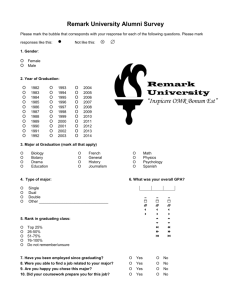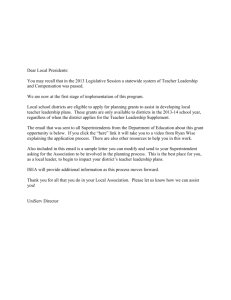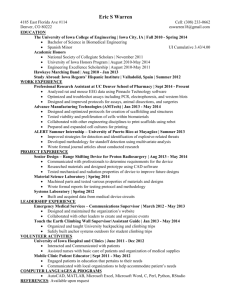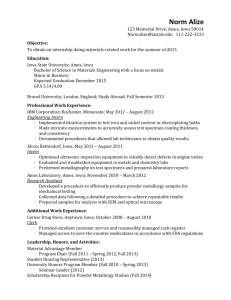HS Requirements 10
advertisement
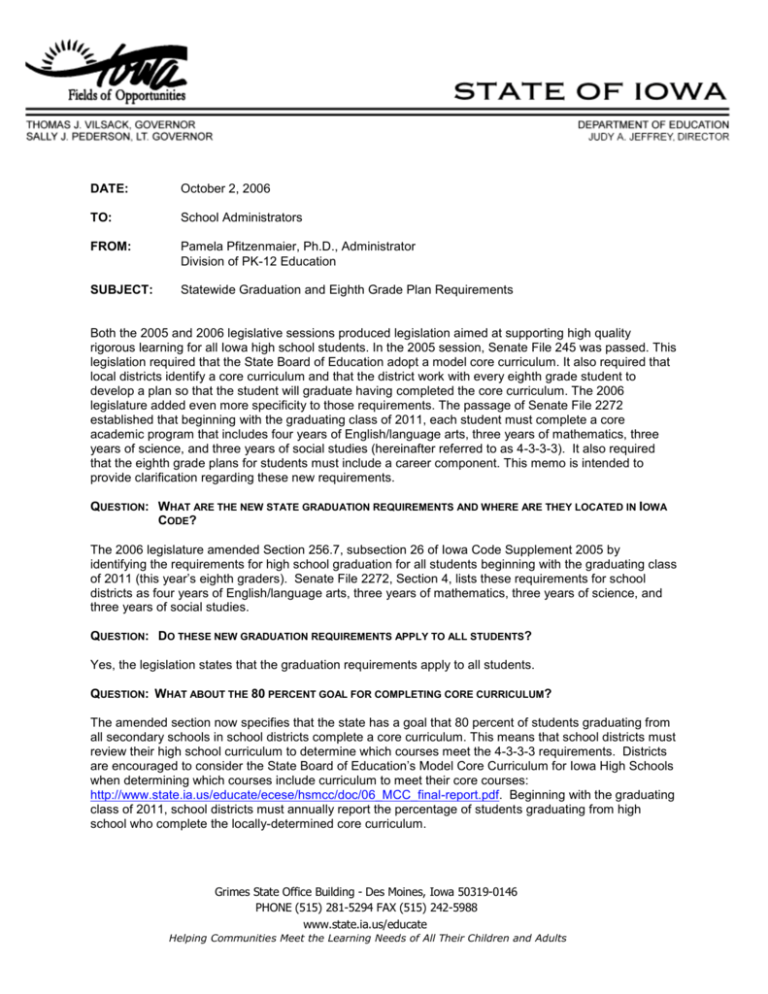
DATE: October 2, 2006 TO: School Administrators FROM: Pamela Pfitzenmaier, Ph.D., Administrator Division of PK-12 Education SUBJECT: Statewide Graduation and Eighth Grade Plan Requirements Both the 2005 and 2006 legislative sessions produced legislation aimed at supporting high quality rigorous learning for all Iowa high school students. In the 2005 session, Senate File 245 was passed. This legislation required that the State Board of Education adopt a model core curriculum. It also required that local districts identify a core curriculum and that the district work with every eighth grade student to develop a plan so that the student will graduate having completed the core curriculum. The 2006 legislature added even more specificity to those requirements. The passage of Senate File 2272 established that beginning with the graduating class of 2011, each student must complete a core academic program that includes four years of English/language arts, three years of mathematics, three years of science, and three years of social studies (hereinafter referred to as 4-3-3-3). It also required that the eighth grade plans for students must include a career component. This memo is intended to provide clarification regarding these new requirements. QUESTION: WHAT ARE THE NEW STATE GRADUATION REQUIREMENTS AND WHERE ARE THEY LOCATED IN IOWA CODE? The 2006 legislature amended Section 256.7, subsection 26 of Iowa Code Supplement 2005 by identifying the requirements for high school graduation for all students beginning with the graduating class of 2011 (this year’s eighth graders). Senate File 2272, Section 4, lists these requirements for school districts as four years of English/language arts, three years of mathematics, three years of science, and three years of social studies. QUESTION: DO THESE NEW GRADUATION REQUIREMENTS APPLY TO ALL STUDENTS? Yes, the legislation states that the graduation requirements apply to all students. QUESTION: WHAT ABOUT THE 80 PERCENT GOAL FOR COMPLETING CORE CURRICULUM? The amended section now specifies that the state has a goal that 80 percent of students graduating from all secondary schools in school districts complete a core curriculum. This means that school districts must review their high school curriculum to determine which courses meet the 4-3-3-3 requirements. Districts are encouraged to consider the State Board of Education’s Model Core Curriculum for Iowa High Schools when determining which courses include curriculum to meet their core courses: http://www.state.ia.us/educate/ecese/hsmcc/doc/06_MCC_final-report.pdf. Beginning with the graduating class of 2011, school districts must annually report the percentage of students graduating from high school who complete the locally-determined core curriculum. Grimes State Office Building - Des Moines, Iowa 50319-0146 PHONE (515) 281-5294 FAX (515) 242-5988 www.state.ia.us/educate Helping Communities Meet the Learning Needs of All Their Children and Adults Page 2 2/12/2016 QUESTION: DOES THIS MEAN THAT STUDENTS WITH INDIVIDUALIZED EDUCATION PROGRAMS (IEPS) DO NOT HAVE TO TAKE CORE CURRICULUM CLASSES? No. Students with IEPs must receive an educational program that is designed for their individualized needs. Determination of those needs, however, begins with the general education curriculum and setting. Any variation of the district’s graduation requirements for an individual student with an IEP must be allowable by the district’s Board policies and be determined by the IEP team based on the individual student’s needs as a result of the student’s disability. QUESTION: WHAT IS THE CORE CURRICULUM RECOMMENDED BY THE COLLEGE TESTING SERVICE WHOSE COLLEGE ENTRANCE EXAM IS TAKEN BY THE MAJORITY OF IOWA’S HIGH SCHOOL STUDENTS? ACT’s policy report, Courses Count: Preparing Students for Postsecondary Success recommends that postsecondary readiness can be increased by requiring specific course sequences and by improving the rigor of high school coursework. The 2006 legislature, in considering these recommendations, established the graduation requirements to be four years of English/language arts, three years of mathematics, three years of science, and three years of social studies. The State Board of Education’s Model Core Curriculum has incorporated the recommendations of both Iowa Tests of Educational Development and ACT for literacy, mathematics and science. QUESTION: WHAT MUST WE REPORT, WHEN MUST WE REPORT IT AND WHERE DO WE REPORT IT? Each school district must report the percentage of students graduating from high school who complete the core curriculum, beginning with the 2011 graduating class. The district must also report in the comprehensive school improvement plan (CSIP) how the district plans to increase the number of students completing the recommended core. Beginning with the 2006-2007 school year, districts must have on file a plan that describes how it will increase the number of students completing the core curriculum. Assurances that such a plan is on file must be included in the CSIP. The CSIP will provide a list of potential actions districts may take to increase the number of students completing the core curriculum. The district may check which, if any, of these actions are included in the district’s plan. The district must then update (save) this information, but certification of the CSIP is not necessary. Further information about how to update your CSIP will follow later in the school year. QUESTION: WHAT ARE THE EIGHTH GRADE PLANNING REQUIREMENTS AND HOW DO THEY AFFECT OUR DISTRICT? Section 279.61 of the Iowa Code Supplement 2005 requires: (1) the board of directors of each school district cooperate with each eighth grade student to develop a student core curriculum plan to guide the student toward the goal of successfully completing the district core curriculum, and (2) the district to annually report on progress toward student completion of the core curriculum plan. QUESTION: WHAT IS A STUDENT CORE CURRICULUM PLAN AND HOW SHOULD IT BE USED? A student core curriculum plan is an individual education plan that guides the student toward the goal of successfully completing, at a minimum, the district’s core curriculum in preparation for postsecondary education and career options. The plan must include career options and identify coursework needed in grades nine through twelve to support the student’s postsecondary and career options. Effective practice suggests that student plans should be living documents that are revised at least annually. For technical assistance on developing and implementing quality student plans, the Department plans to release Developing Quality Plans to Help Students Grow, Prepare, and Succeed. This document is being developed by the Department and will be available on the Department’s website under New and Revised Content by October 6. Page 3 2/12/2016 QUESTION: WHEN DO WE HAVE TO START DEVELOPING A STUDENT CORE CURRICULUM PLAN? The 2006-2007 eighth grade class is the first set of students who must have a student plan for coursework needed in grades nine through twelve. QUESTION: WHO HAS TO BE INVOLVED IN THE DEVELOPMENT OF THE STUDENT’S PLAN? Each eighth grade student must be involved in the development of the student’s plan. Iowa Code also requires that a parent or guardian of students under the age of 18 sign the plan. QUESTION: WHAT DO WE HAVE TO REPORT TO STUDENTS AND THEIR PARENTS/GUARDIANS AND WHEN DO WE HAVE TO REPORT IT? The district must report annually to each student enrolled in grades nine through twelve in the school district and their parent or guardian, the student’s progress toward meeting the goal of successfully completing the model core curriculum. If you have any questions, please contact Rita Martens at rita.martens@iowa.gov or (515) 281-3145.
